
Kathmandu, officially Kathmandu Metropolitan City, is the capital and most populous city of Nepal with 845,767 inhabitants living in 105,649 households as of the 2021 Nepal census and 2.9 million people in its urban agglomeration. It is located in the Kathmandu Valley, a large valley in the high plateaus in central Nepal, at an altitude of 1,400 metres.
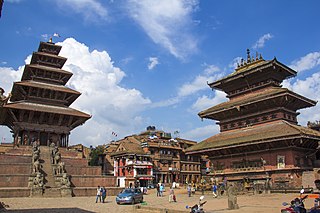
Bhaktapur, known locally as Khwopa and historically called Bhadgaon, is a city in the east corner of the Kathmandu Valley in Nepal located about 13 kilometres (8.1 mi) from the capital city, Kathmandu. Bhaktapur is the smallest city of Nepal as well the most densely populated. Along with Kathmandu and Lalitpur, Bhaktapur is one of the three main cities of the Kathmandu Valley and is a major Newar settlement of the country. The city is also known for its Newar tradition, cuisine and artisans. Bhaktapur suffered heavy damage in the April 2015 earthquake.

Newar or Newari, known officially in Nepal as Nepal Bhasa, is a Sino-Tibetan language spoken by the Newar people, the indigenous inhabitants of Nepal Mandala, which consists of the Kathmandu Valley and surrounding regions in Nepal.

Newar or Nepami, are the historical inhabitants of the Kathmandu Valley and its surrounding areas in Nepal and the creators of its historic heritage and civilisation. Newars form a linguistic and cultural community of primarily Indo-Aryan and Tibeto-Burman ethnicities following Hinduism and Buddhism with Nepal Bhasa as their common language. Newars have developed a division of labour and a sophisticated urban civilisation not seen elsewhere in the Himalayan foothills. Newars have continued their age-old traditions and practices and pride themselves as the true custodians of the religion, culture and civilisation of Nepal. Newars are known for their contributions to culture, art and literature, trade, agriculture and cuisine. Today, they consistently rank as the most economically and socially advanced community in Nepal, according to the annual Human Development Index published by UNDP. Newars are ranked the 8th largest ethnic group in Nepal according to the 2021 Nepal census numbering 1,341,363 people constituting 4.6% of the total population.

The Kathmandu Valley, also known as the Nepal Valley or Nepa Valley, National Capital Area, is a bowl-shaped valley located in the Himalayan mountains of Nepal. It lies at the crossroads of ancient civilizations of the Indian subcontinent and the broader Asian continent, and has at least 130 important monuments, including several pilgrimage sites for Hindus and Buddhists. There are seven World Heritage Sites within the valley.
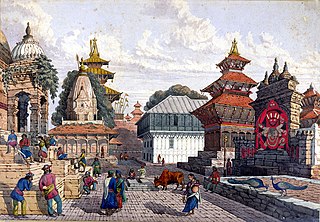
The Malla dynasty was the ruling dynasty of the Kathmandu Valley in Nepal from 1201 to 1779. This dynasty was founded by Arideva Malla. Though latter Mallas were regarded as belonging to the Raghuvamsha dynasty, they were also seen as continuation and descendants of the Licchavi dynasty. Later Malla kings also traced one section of their lineage from Nanyadeva, the founder of the Karnat dynasty of Mithila. The term malla means wrestler in Sanskrit. The first use of the word malla in the Kathmandu Valley begins from 1201.

Nepali architecture or Nepalese architecture is a unique blend of artistic and practical considerations. Situated between the trade routes of India, Tibet and China, Nepali architecture reflects influences from these cultural strongholds. The pagoda architectural tradition figures prominently among Hindu temples in the country. In contrast, Buddhist temples reflect the Tibetan tradition of Buddhist architecture and the stupa features prominently. Mugal, summit and dome styles also have great scope in Nepal. Whilst significant influence for Nepal's architecture comes from India, there is also a distinct influence from the Newar people.

The Newar language of Nepal has the fourth oldest literature tradition among the Sino-Tibetan languages.

Bajrayogini Temple(Nepali: बज्रयोगिनी मन्दिर) is a Tantric Buddhist temple located at Sakwa in Nepal's Kathmandu Valley. It is also well known as Bodhisattva's Temple. The temple is actually a sort of temple complex, with the main temple having been built by King Pratap Malla in the sixteenth century. Vajrayogini is a Buddhist tantric deity, she is also conflated with Ugra Tara, a form of the Buddhist dharmapala Ekajati. However, the temple is sacred to both Buddhists and Hindus.

Newar caste system is the system by which Newārs, the historical inhabitants of Kathmandu Valley, are divided into groups on the basis of Vedic varna model and divided according to their hereditary occupations. First introduced at the time of the Licchavis, the Newar caste system assumed its present shape during the medieval Malla period. The Newar caste structure resembles more closely to North India and Madheshis than that of the Khas 'Parbatiyas' in that all four Varna and untouchables are represented. The social structure of Newars is unique as it is the last remaining example of a pre-Islamic North Indic civilisation in which Buddhist elements enjoy equal status with the Brahmanic elements.

Nepalese scripts are a family of alphabetic writing systems employed historically in Nepal Mandala by the indigenous Newars for primarily writing Nepal Bhasa. It is also used for transcribing Sanskrit and Pali. There are also some claims they have also been used to write the Parbatiya (Khas) language.

Nepal Bhasa movement refers to the struggle for linguistic rights by Newar speakers in Nepal in the face of opposition from the government and hostile neighbors. The campaign aims to increase the use of Nepal Bhasa in the home, education, government and business. Despite a high level of development, Newar culture and language are both under threat.

Madhyapur Thimi, also known as Thimi, is a municipality in Bhaktapur District in the Bagmati Zone of central Nepal. Thimi lies between Kathmandu, Lalitpur and Bhaktapur in the Kathmandu Valley. It is one of the ancient cultural and historical places along the trade route from Bhaktapur to Kathmandu. The city is situated on elevated land and occupies an area of 11.47 square kilometres (4.43 sq mi), divided into nine administrative wards.

Kathmandu Durbar Square is a historically and culturally significant site in Kathmandu, Nepal. It is one of the three Durbar Squares in the Kathmandu Valley in Nepal that are UNESCO World Heritage Sites.

Bhaktapur Durbar Square is a former royal palace complex located in Bhaktapur, Nepal. It housed the Malla kings of Nepal from 14th to 15th century and the kings of the Kingdom of Bhaktapur from 15th to late 18th century until the kingdom was conquered in 1769. Today, this square is recognised by UNESCO, managed jointly by the Archeological Department of Nepal and Bhaktapur Municipality, and is undergoing extensive restoration due to the damages from the earthquake in 1934 and the recent earthquake of 2015.
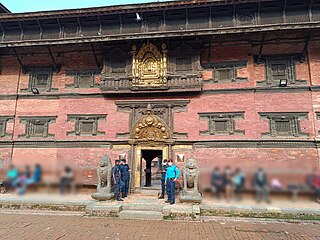
Patan Durbar Square is situated at the centre of the city of Lalitpur in Nepal. It is one of the three Durbar Squares in the Kathmandu Valley, all of which are UNESCO World Heritage Sites. One of its attractions is the medieval royal palace where the Malla Kings of Lalitpur resided.
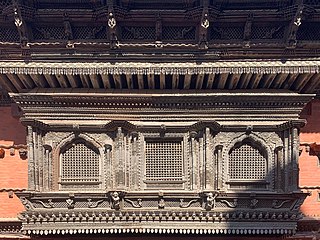
Newār window refers to the elaborately carved wooden window which is the distinguishing feature of traditional Nepalese architecture. The ornate windows have been described as a symbol of Newar culture and artistry. The level of design and carving of the Newar window reached its peak in the mid-18th century. They are found on palaces, private residences and sacred houses across Nepal Mandala.

Urāy is a Newar Buddhist merchant caste of Kathmandu in Nepal. They are a prominent community in the business and cultural life of Kathmandu. Urays have played key roles in the development of trade, industry, art, architecture, literature and Buddhism in Nepal and the Himalayan region.

Traditional Newar clothing refers to the everyday clothes worn by the Newar people of Nepal who are indigenous to the Kathmandu Valley and surrounding regions. The garments are associated with the old aristocracy, merchants, farmers, craftsmen and professionals.
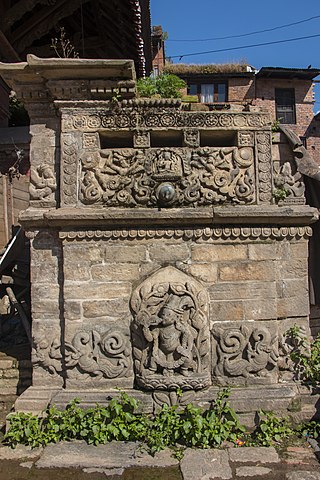
A tutedhara (Nepali) or jahru (Newari) is a traditional drinking fountain found in Nepal. It is a water reservoir built out of stone with a tap that can be opened and closed. These structures are either free-standing or integrated into the wall of another building. They depend on a water well or a dhunge dhara to be filled. Only a few of them are in use today, but some of the stone parts have been put to other uses, and there are contemporary equivalents. The best known tutedhara is the one built into a wall in the royal palace on Kathmandu Durbar Square. It is inscribed with a poem dedicated to the goddess Kali, written in fifteen different languages.






















